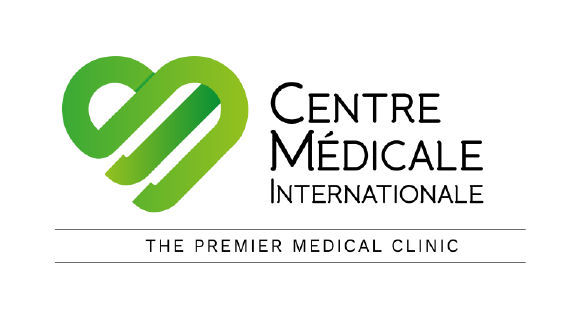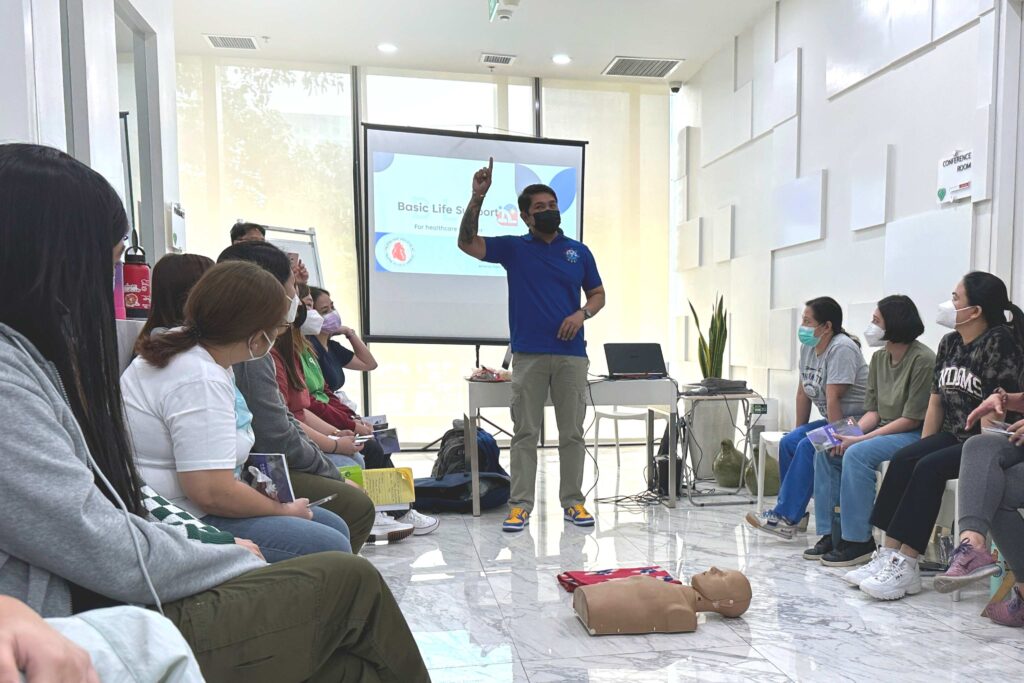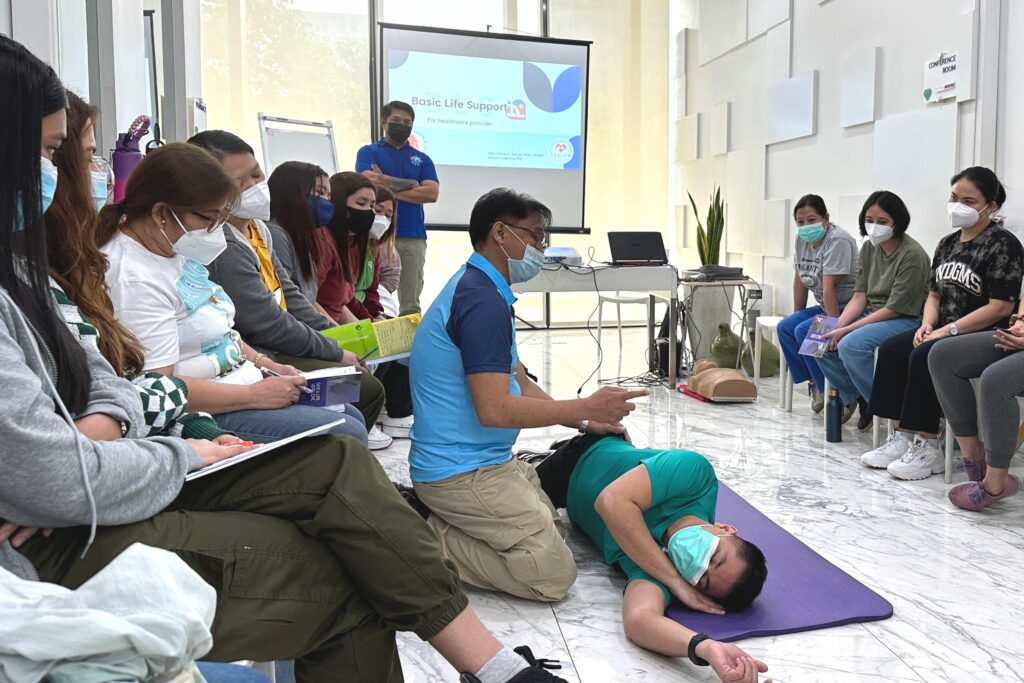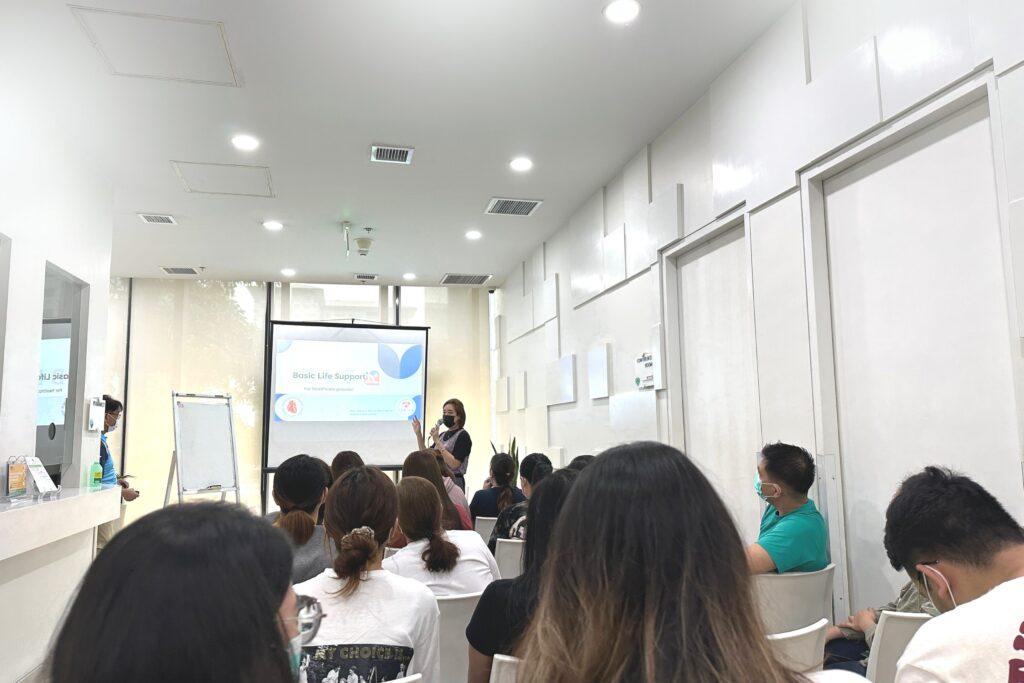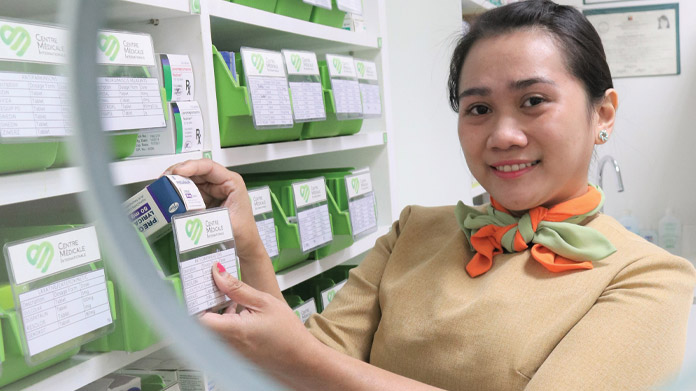Preserve life. Prevent further illness. Promote recovery.
CMI organizes a Basic Life Support training course for employees
By Joy Rojas
What would you do if you were suddenly faced with a medical emergency?
At the height of the pandemic in 2020, Chamie Isidro, physical therapist and assistant clinic manager of Centre Medicale Internationale (CMI), was leaving work when she saw a crowd gather before victims of a hit and run. Sitting on the ground after his motorcycle was struck by a van, a man cradled his daughter’s head on his lap. Both were stable and lucid but suffered deep, gaping wounds from the accident—he on his arms, she on her arms and knee.
The first thing Chamie did was to assess them for injuries. Upon ruling out fractures and establishing that they could move their arms and legs with minimal pain, she enlisted the help of Bonifacio Global City’s (BGC) road marshals to carefully transfer the victims from the busy street to the sidewalk. There, she administered wound care on the father and daughter while waiting for BGC’s ambulance to arrive.
Just this Valentine’s, CMI senior cardio-neuro technician Ann Presenta was overseeing a client taking a treadmill stress test, when he experienced sudden syncope or loss of consciousness while seated during his recovery period. To revive him in seconds, Ann performed some first aid procedures that brought the patient back to consciousness.
“Medical emergencies can happen anytime, anywhere, and to anyone,” says Ann. “We need to be focused and alert at all times.”
Basic Life Support
With this in mind, CMI organized Basic Life Support (BLS) training for 40 members of its staff on February 20 at the CMI clinic in Ore Centrale Building, BGC, Taguig City. Scheduled every two years, BLS trainings for CMI employees started in 2017.
Presented by the Philippine Heart Association (PHA), the 2023 BLS training at CMI began days before with a series of online videos to familiarize participants with the various types of life support. On the training day itself, staffers attended face-to-face lectures and practiced CPR (Cardio-Pulmonary Resuscitation) on a manikin. Written and practical exams allowed them to avail of certification.
Lectures covered Adult and Pediatric Basic Life Support, Foreign Body Airway Obstruction (Choking), Life-Threatening Conditions and First Aid Response (Stroke, Chest Pain, Hypoglycemia, Animal Bites, etc.), Ethics in Resuscitation, and Actual CPR.
Mr. Jhune Tolentino, one of the trainers from PHA, explains how to do correct CPR
Mr. Felix Ramos demonstrates to the staff how to properly place a victim in recovery position after successfully reviving a patient
Reacting in times of emergencies
“I wanted the BLS training cascaded to our employees so that even at home, or when they are with their loved ones, they would know how to react in times of emergencies or any accidents,” says CMI President Michelle Diño. “Maybe during a panic situation, the employee will not be able to remember everything taught in the course. However, what is important is they know the basics: that they should call an ambulance, that they should ensure the area is safe before touching the patient. And that in case they cannot do the actual CPR, at least they can guide another person to perform that procedure in order to save other people’s lives.”
Ms. Michelle Dino, CMI President, started the morning with some opening remarks before the training session
CMI’s healthcare providers were certainly grateful for the training. “I appreciate management’s initiative to equip us with more knowledge and skills for critical medical situations,” says Ann, who has attended all of CMI’s BLS trainings.
Even CMI’s non-medical staff found the course relevant. “It’s my first time to attend a BLS training, and I think it’s a big help especially these days when accidents can happen anytime,” says Marc Monteiro, CMI’s billing and disbursement associate.
“It gives us a sense of responsibility,” says Rae Roque, CMI’s assistant marketing manager. “If a client needs our help, we can immediately attend to him or her instead of waiting for someone from our medical team who might be attending to another client.”
“Personally, it’s added learning,” she continues. “I can help someone—a family member, a stranger—because I know what to do while waiting for emergency medical responders.”
Latest life-saving techniques
Apart from serving as a refresher course, regular BLS trainings update participants on the latest first aid and life-saving protocols. For instance, treating a snake bite these days no longer calls for sucking on the wound and spitting out the venom, or applying a tourniquet. One simply washes the wound thoroughly with soap and water, applies a clean and cool compress over the wound, keeps the bitten area still and lower than the heart, and removes watches, rings, and other constricting clothing to avoid swelling.
Even CPR has evolved largely because of COVID-19. Performing it requires first responders to don gloves, PPE (personal protective equipment), and a barrier mask to prevent transmitting droplets of saliva, which may be infected with the coronavirus, to a patient. In the absence of a barrier mask, a handkerchief or extra T-shirt would do, said the trainers.
Techniques are also constantly refined. If the BLS training for CPR in 2019 emphasized pumping hard and fast, 2023’s BLS training focused on high-quality CPR, from the correct placement of the hands on the chest to the steady rhythm of the resuscitation act.
Some of the staff during the practical exam
As for the Chain of Survival, which is defined as a series of properly executed actions that reduce the mortality associated with sudden cardiac arrest, that too has evolved from the original three to five to the current six. “The guide is updated every five years,” says Rae. “It’s become more holistic.”
Stroke, which, like cardiac arrest, happens when you least expect it, can now be dealt with swiftly by using the acronym BE FAST to detect signs and symptoms: Balance (as in the loss of it), Eyes (or blurred vision), Face (when one side is drooping), Arms (can the patient raise both?), Speech (check for slurring), and Time (the window for stroke treatment is 3-4.5 hours after the onset of symptoms).
Yet for all the changes that Basic Life Support has undergone through the years, the goals remain the same. “Preserve life. Prevent further illness. Promote recovery,” recites Ann.
One of CMI’s doctors during the practical exam
Not afraid to help
Though Marc and Rae have not had to use their BLS training in real-life situations, both won’t hesitate to step in and extend assistance should an emergency arise. “We shouldn’t be afraid to help,” says Marc.
Admittedly, it takes a different mindset to jump in and provide first aid to a stranger, friend, or family member in a life-or-death situation. “You have to have the willingness, confidence, and physical strength for it. It takes a very brave and committed person to put everything he or she learned to good use when the time comes,” says Chamie.
Still, knowing how is enough. “If you don’t have the strength to do the chest compressions on a patient with cardiac arrest, you at least have the correct knowledge on what to do and can guide someone else to do it,” says Rae.
“You can be the second responder and the person performing the first aid is the first responder,” affirms Ann. “Everybody can be a life saver.”
CMI team with the Philippine Heart Association Trainers
CMI is located at 2/F Ore Central Bldg., 31st corner 9th Avenue, Bonifacio Global City, Taguig. For inquiries and appointment scheduling for your outpatient medical needs, you may call + 63 2 8812-1264, +63 2 8816-1035 to 36 or visit www.cmi.care.

